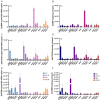Fate of Horizontal-Gene-Transfer Markers and Beta-Lactamase Genes during Thermophilic Composting of Human Excreta
- PMID: 36838273
- PMCID: PMC9958827
- DOI: 10.3390/microorganisms11020308
Fate of Horizontal-Gene-Transfer Markers and Beta-Lactamase Genes during Thermophilic Composting of Human Excreta
Abstract
Thermophilic composting is a suitable treatment for the recycling of organic wastes for agriculture. However, using human excreta as feedstock for composting raises concerns about antibiotic resistances. We analyzed samples from the start and end of a thermophilic composting trial of human excreta, together with green cuttings and straw, with and without biochar. Beta-lactamase genes blaCTX-M, blaIMP, and blaTEM conferring resistance to broad-spectrum beta-lactam antibiotics, as well as horizontal gene transfer marker genes, intI1 and korB, were quantified using qPCR. We found low concentrations of the beta-lactamase genes in all samples, with non-significant mean decreases in blaCTX-M and blaTEM copy numbers and a mean increase in blaIMP copy numbers. The decrease in both intI1 and korB genes from start to end of composting indicated that thermophilic composting can decrease the horizontal spread of resistance genes. Thus, thermophilic composting can be a suitable treatment for the recycling of human excreta.
Keywords: antibiotic resistance; compost; ecological sanitation; horizontal gene transfer; qPCR.
Conflict of interest statement
The authors declare no conflict of interest.
Figures


References
-
- Ryals R., Bischak E., Porterfield K.K., Heisey S., Jeliazovski J., Kramer S., Pierre S. Toward zero hunger through coupled ecological sanitation-agriculture systems. Front. Sustain. Food Syst. 2021;5:716140. doi: 10.3389/fsufs.2021.716140. - DOI
-
- Ryckeboer J., Mergaert J., Vaes K., Klammer S., De Clercq D., Coosemans J., Insam H., Swings J. A survey of bacteria and fungi occurring during composting and self-heating processes. Ann. Microbiol. 2003;53:349–410.
Grants and funding
LinkOut - more resources
Full Text Sources

